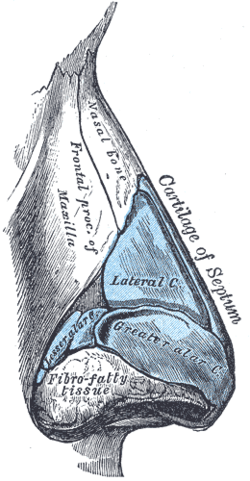Transverse nasal crease
| Transverse nasal crease | |
|---|---|
 Cartilage and skin of the nose may become damaged when the nose is repeatedly creased due to the allergic salute. Side view. | |
The transverse nasal crease or groove is a usually white line between the upper two-thirds and the lower third of the human nose (slightly above the cartilage tip between the bridge and nostrils). It can occur as the result of heredity, accident, or the constant rubbing or wiping of the nose, commonly referred to as the allergic salute.[1][2]
Occurrence
In addition to cases caused by heredity, physical injury, the transverse nasal crease is common in children and adults with chronic nasal allergies. Allergy sufferers often use their hands to remove mucous from a runny nose or rub an itchy nose. As the hand slides upward, the tip of the nose is pressed up, thus creating the crease.[3]
Appearance
On most people, the transverse nasal crease is lighter in color than the surrounding skin, and may appear white. This is due to hypopigmentation resulting from the low level of melanin present in the damaged skin.[4] In darker-skinned peoples, who have a high level of melanin in their skin, the line may appear dark brown or black.
References
- ↑ Shelley, W.B.; Shelley, E.D.; Pansky, B. (1997). "The transverse nasal line: An embryonic fault line". British Journal of Dermatology. 137 (6): 963–5. doi:10.1046/j.1365-2133.1997.19942075.x. PMID 9470916.
- ↑ Ramot, Yuval; Maly, Alex; Zlotogorski, Abraham; Nanova, Krassimira (2010). "Atypical 'allergic crease'". Journal of Dermatological Case Reports. 4 (3): 36–7. doi:10.3315/jdcr.2010.1054. PMC 3157813
 . PMID 21886747.
. PMID 21886747. - ↑ "Are Your Allergic?".
- ↑ https://web.archive.org/web/20140720072316/http://www.dermatlas.com/derm/result.cfm?Diagnosis=1004497223. Archived from the original on July 20, 2014. Retrieved July 20, 2012. Missing or empty
|title=(help)